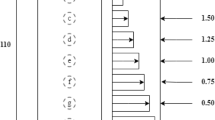Abstract
Active infrared thermography (AIRT) has emerged as an extensively applied non-destructive testing and imaging (NDT&I) methodology for examining the characteristics of the material, without impacting their future utility. The proposed work demonstrates the evaluation of a glass fiber reinforced polymer (GFRP) composite test sample fabricated with flat bottom holes as defects at varying depths using frequency modulated thermal wave imaging (FMTWI) as an emerging nonstationary thermal wave imaging (NSTWI) modality. The properties of pulse compression favorable FMTWI is eminent for compressing the total imposed thermal energy into a narrow pulse to enhance the depth resolution as well as the test sensitivity. The reliability analysis of pulse compression favorable FMTWI method is achieved via a statistical parameter known as probability of detection (PoD). In this paper, continuous signal response model is taken into consideration by computing the area under the main central lobe of the reconstructed profiles, obtained from the process of cross-correlation at all depths of GFRP specimen. For statistical evaluation, peak signal-to-noise ratio (PSNR) and Tanimoto criterion have been used as parameters of merit. Moreover, the framework based on estimation of probability of detection considering main lobe area (MLA) for apparent visibility and resolution of defects has been proposed. The results claim that by applying MLA as a statistical feature of reliability estimation, the defects having higher aspect ratio are detected with more than 90% probability.




Similar content being viewed by others
REFERENCES
Hellier, C., Handbook of Nondestructive Evaluation, New York: McGraw-Hill Prof. Publ., 2001.
Bergmann, R. and Huke, P., Advanced methods for optical nondestructive testing, in Optical Imaging and Metrology: Advanced Technologies, Hoboken: Wiley, 2012, pp. 393–412.
Maldague, X., Theory and Practice of Infrared Thermography for Nondestructive Testing, Hoboken: Wiley, 2001.
Sakagami, T. and Kubo, S., Applications of pulse heating thermography and lock- in thermography to quantitative non-destructive evaluations, Infrared Phys. Technol., 2002, vol. 43, nos. 3–5, pp. 211–218.
Shepard, S.M., Introduction to active thermography for non-destructive evaluation, Anti-Corros. Meth. Mater., 1997, vol. 44, no. 4, pp. 236–239.
Busse, G., Wu, D., and Karpen, W., Thermal wave imaging with phase sensitive modulated thermography, J. Appl. Phys., 1992, vol. 71, no. 8, pp. 3962–3965
Wu, D. and Busse, G., Lock–in thermography for nondestructive evaluation of materials, Rev. Gener. Thermique, 1998, vol. 37, no. 8, pp. 693–703.
Almond, D.P. and Peng, W., Thermal imaging of composites, J. Microsc., 2001, vol. 201, no. 2, pp. 163–170.
Ghali, V.S., Mulaveesala, R., and Takei, M., Frequency-modulated thermal wave imaging for non-destructive testing of carbon fiber-reinforced plastic materials, Meas. Sci. Technol., 2011, vol. 22, no. 10, p. 104018.
Mulaveesala, R. and Tuli, S., Implementation of frequency-modulated thermal wave imaging for non-destructive sub-surface defect detection, Insight: Nondestr. Test. Cond. Monit., 2005, vol. 47, no. 4, pp. 206–208.
Mulaveesala, R. and Tuli, S., Theory of frequency modulated thermal wave imaging for non-destructive sub-surface defect detection, Appl. Phys. Lett., 2006, vol. 89, no. 19, p. 191913.
Kher, V., Mulaveesala, R., Rani, A., and Arora, V., Investigations on probability of defect detection using differential filtering for pulse compression favorable frequency modulated thermal wave imaging for inspection of glass fiber reinforced polymers, IOP SciNotes, 2020, vol. 1, no. 2, p. 024407.
Meeker, W.Q. and Escobar, L.A., Statistical methods for reliability data, Hoboken: Wiley, 2021.
Kher, V. and Mulaveesala, R., Probability of defect detection in glass fibre reinforced polymers using pulse compression favorable frequency modulated thermal wave imaging, Infrared Phys. Technol., 2021, vol. 113, p. 103616.
Arora, V., Mulaveesala, R., Rani, A., Kher, V., et al., Infrared image correlation for non-destructive testing and evaluation of materials, J. Nondestr. Eval., 2021, vol. 40, p. 75.
Author information
Authors and Affiliations
Corresponding author
Ethics declarations
The authors declare that they have no conflicts of interest.
Rights and permissions
About this article
Cite this article
Kher, V., Mulaveesala, D.R. Statistical Analysis of Defect Dection in Glass Fiber Reinforced Polymers Using Frequency Modulated Thermal Wave Imaging. Russ J Nondestruct Test 58, 405–410 (2022). https://doi.org/10.1134/S1061830922050084
Received:
Revised:
Accepted:
Published:
Issue Date:
DOI: https://doi.org/10.1134/S1061830922050084




